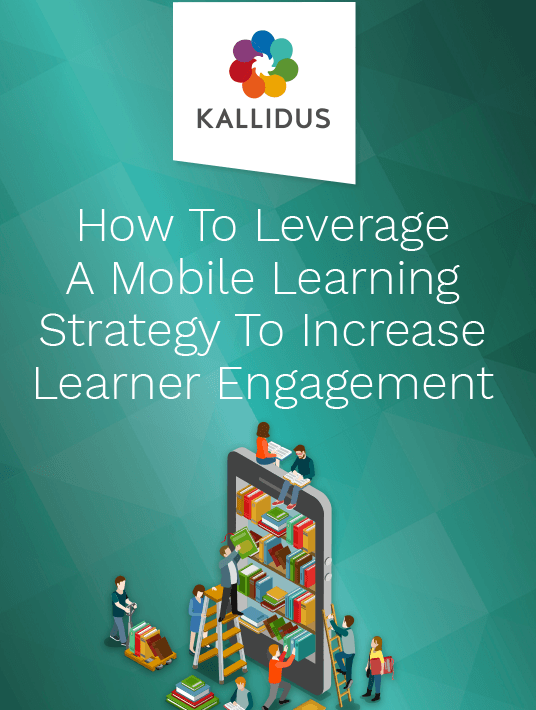Why Integrate Microlearning Nuggets Into Your Mobile Learning Strategy?
Microlearning is one of those terms you will have heard or read somewhere in the sphere of L&D. An especially hot topic in a professional increasingly occupied with mobile devices, microlearning is the perfect content accompaniment to adapting learning technologies. In case you’re not 100% sure, let’s look at a definition.

What Is Microlearning?
Microlearning is a form of eLearning that typically takes anywhere from 2-10 minutes to complete. Often in the form of videos and animations, these bite-size chunks (or nuggets) play to the strengths of modern learners as well as providing a wide range of benefits to mobile learning. Now we have a clearer understanding of what microlearning is, it’s time to look a little deeper into the benefits it presents to learning engagement, and why it should be a vital component of your mobile learning strategy.
1. Holding Your Learners’ Attention
It’s a well-known fact that our attention spans are getting shorter. In the age of instant gratification, mobile apps for everything, and constant distraction, it can be hard to get modern learners to focus for a long period of time. Not only this, but the retention of information decreases dramatically after the first few minutes. On Facebook, for example, videos are rarely watched past the 1-minute mark and even on YouTube, a platform made entirely for video, drop off rates peak at 4-5 minutes. Therefore, when creating eLearning content, in video form or not, it is vital we take notice of the attention spans of modern learners. Microlearning complements the speed of modern learners lives, attention spans, and interactions.
2. Improving Information Retention
While a lot of eLearning, especially compliance, may be mandatory within your organisation, engagement with this information might not be what it needs to. Mandatory training isn’t often the most exciting and as we saw above, average internet users switch off after just a few minutes. Completion rates are no longer a good indication of how compliant your organisation is or how engaged your learners are with their content. Breaking down this content into bite-size chunks through microlearning makes it far easier for your learners to retain the information presented to them. Mobile learning naturally promotes flexibility and microlearning allows your workforce to learn and retain information whenever and wherever it suits them.
3. Increasing Learner Engagement
Due to the shortened length of the learning content, modern learners are more likely to complete additional courses when presented with microlearning. If someone has to set aside half an hour or an hour for a single piece or learning, chances are they will mentally switch off and just sit there until the necessities are done. With smaller chunks of learning, they are more likely to take the initiative to continue their search for information. You may have heard the term “falling down the rabbit hole” in reference to content services such as YouTube or Netflix. This quest for information and entertaining content, especially on YouTube, can lead to a whole variety of new discoveries. The shorter and more succinct the information or piece of entertainment is, the more likely we are to keep going. The same principle applies to microlearning which taps into habits primed by regular use of mobile devices. Additional, self-directed and continuous learning are not just buzzwords in L&D, they’re considered vital measurements of learning engagement.
4. Heightening The Sense Of Achievement
No matter your role within an organisation (or even in our day to day lives), checking items off of a to-do list comes with a little spark of achievement. People who break down their things to do into smaller chunks are much more likely to finish their lists due to the motivation from an increased number of wins or completions. Microlearning works in exactly the same way. Even without us realising it, completing an item from a to-do list (whether that’s shopping, errands, work tasks, or training) triggers the reward system in our brains. We feel good about what we’ve achieved and like we’re taking a step closer to our goals. Conducting all training in larger chunks of anything from 30 minutes to several hours is a sure-fire way to demotivate learners. Especially if you’re asking them to complete training on mobile.
5. Fitting Learning Into Tight Schedules
The modern-day workforce is likely to be working longer hours, taking fewer breaks, and achieving more work in a single day than ever before. Schedules are getting tighter, and L&D need to adjust to this in order not to lose engagement levels and completion rates. Microlearning, alongside a mobile learning strategy, allows for greater flexibility in your learners’ schedules. Whether an employee has five minutes before a meeting or a few minutes at the end of the working day, these moments are the perfect opportunity to catch up on mandatory training and point-of-need learning. Mobile allows this to happen anytime, anywhere, and microlearning is the perfect complement to these needs.
6. Allowing For Weaker Internet And Lower Battery Life
The practical realities of using mobile devices are that they have weaker internet connections and lower battery lives than desktop PCs and laptops. Moving to a mobile-led strategy means that your content has to be adapted for the limitations of a mobile-friendly LMS. Microlearning does this by greatly reducing the bandwidth needed for content to lead (also, therefore, reducing loading times which is vital for engagement levels). Smartphones and tablets are also notorious for their draining batteries, so whether you are supplying these devices of encouraging BYOD (bring your own device) learning, it has to be considered that these devices may not be able to sustain longer periods of visual and interactive training.
7. Better Adapted For Mobile Devices And Blended Learning
Simply put, microlearning is better adapted for mobile devices than just about any other kind of learning there is. Microlearning modules can also be incorporated into blended learning strategies without distracting from the main event in-classroom. Made possible by the use of mobile devices, directly blended learning, by which we mean combining classroom and eLearning within a single training session, is a fantastic way to encourage collaboration and increase engagement. The size of microlearning is better suited for mobile in ways we’ve already discussed such as internet usage, attention spans, and battery life, but it also tends to be designed in a way that’s more responsive to smaller screens. In short, microlearning is the perfect accompaniment to your mobile learning strategy.
Download the free eBook How To Leverage A Mobile Learning Strategy To Increase Learner Engagement to learn how collaboration, microlearning, strategy development and a transformation to mobile learning can enable you to really boost engagement.

